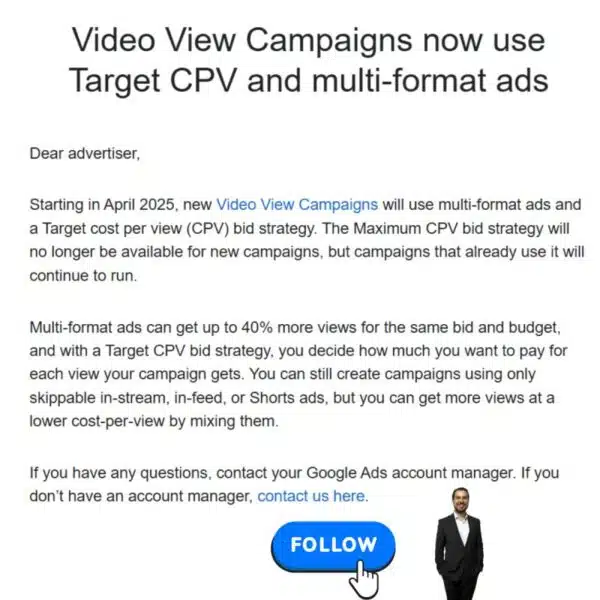Google sunsets Maximum CPV strategy for Video View campaigns
Google's shift from Maximum CPV to Target CPV in Video View Campaigns allows for better control over cost targets of video campaigns.
Google Ads will make significant changes to Video View Campaigns starting in April. Google is introducing a Target Cost-Per-View (CPV) bidding strategy and replacing the Maximum CPV option for new campaigns.
Existing campaigns using Maximum CPV can continue running, but all new campaigns must adopt the updated strategy.
The shift to Target CPV aims to give advertisers greater control over how much they’re willing to pay per view, while multi-format ads promise better efficiency.
Campaigns using a mix of formats — skippable in-stream, in-feed, and Shorts ads — can achieve up to 40% more views for the same budget compared to single-format campaigns, according to Google data.
Key details:
- Multi-format ads. Advertisers can now combine different ad formats within a single campaign, optimizing reach and cost-effectiveness. While mixing formats is encouraged for better results, advertisers still have the flexibility to focus on specific formats like Shorts-only or in-stream-only campaigns.
- Target CPV. This strategy lets advertisers define their desired cost-per-view, providing a more tailored approach to budgeting and performance.
- Sunsetting Maximum CPV. While existing campaigns using Maximum CPV will remain operational, advertisers should anticipate a future migration to the new bidding model.
Why we care. This update represent a fundamental shift in how video advertising costs and performance will be managed. The introduction of Target Cost-Per-View (CPV) bidding gives you more precise control over video ad spending compared to the Maximum CPV model, allowing you to set specific cost targets rather than just upper limits.
The email. This update was first brought to our attention by Georgi Zayakov on LinkedIn where he shared the message he received from Google about this update:

Google highlights that multi-format campaigns can drive better performance at a lower cost-per-view.
Zayakov also shared that he is “experimenting with Shorts-Only and In-Stream-Only Target CPV campaigns, and they perform well even when separated.”
What’s next. Advertisers should evaluate their campaigns and consider transitioning to Target CPV to align with the updated strategy.
- For those looking to optimize views and costs, experimenting with multi-format setups could unlock better performance.
Bottom line. Google’s updates signal a push for more flexible and efficient video ad campaigns. Advertisers should act now to adapt to the changes and leverage the potential benefits of Target CPV and multi-format ads.
Related stories